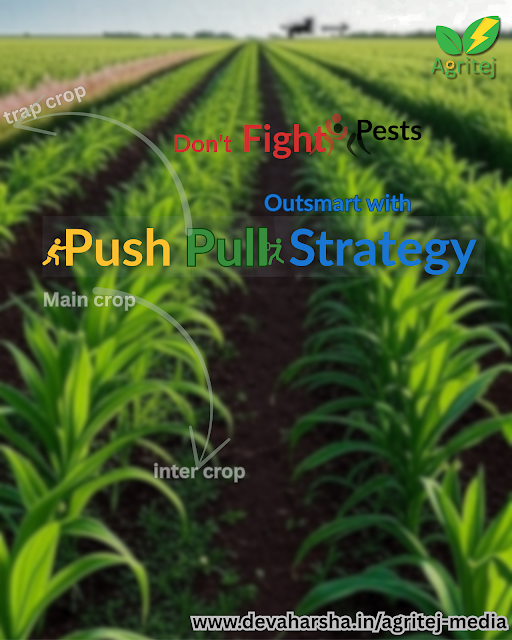How do you protect a crop from a devastating pest? You don't just fight it—you give it directions, leading it straight into a trap.

The Push-Pull Ecological Pest Control Strategy
One of the most elegant and effective forms of pest control isn't found in a bottle; it's meticulously designed into the very layout of the farm. This concept is called the "Push-Pull" strategy, a brilliant form of ecological engineering pioneered by leading research centres like the
This strategy is a masterclass in using plant chemistry to manipulate insect behavior, creating a powerful, multi-layered defense system. It's a critical tool being adapted globally to fight invasive pests like the Fall Armyworm, a major threat to farmers in India and across the world.
How This Brilliant Strategy Works
The Push-Pull system is built on two simple but powerful principles: a repellent "push" from within the crop and an irresistible "pull" towards the field's edge.
The 'Push' – Repelling from the Inside
An "intercrop" plant, such as Desmodium, is planted in between the rows of the main crop (for example, maize). Desmodium releases natural volatile organic compounds (VOCs) that pests find repulsive. These airborne signals effectively 'push' the pests away, creating a protective shield around the valuable crop.
The 'Pull' – Luring to the Outside
Simultaneously, a highly attractive "trap crop," like Napier or Brachiaria Grass, is planted as a border around the entire field. This border grass emits its own chemical signals that are irresistible to the pests. This 'pulls' them to the edges of the field to lay their eggs, far away from the main harvest where they can be more easily managed.
The Result: A Living, Intelligent System
The main crop is ingeniously protected from both sides. This system offers remarkable benefits beyond just pest control:
Drastically reduces the need for chemical pesticides, saving money and protecting the environment.
Improves soil health, as the Desmodium intercrop is a legume that fixes nitrogen in the soil.
Provides high-quality animal fodder from the border trap crops.
This is the power of Integrated Pest Management (IPM) in action—a strategy that works with nature's complex chemistry, not against it.
An Entomologist's Perspective
From my perspective as an agricultural entomologist and in my role as Co-founder & Scientific Advisor at Agri Tej Media, I find the Push-Pull strategy to be one of the most beautiful examples of applied chemical ecology. It's a living, intelligent system, not a one-time chemical application. It acknowledges that pests are organisms responding to signals, not just enemies to be eradicated. By manipulating those signals, we can guide their behavior. This is the kind of systems-level thinking that
About the Author
Anka Pujitha Suddapalli is the Co-founder & Scientific Advisor of Agri Tej Media. As a passionate Agricultural Entomologist, her vision is to empower farmers and agricultural communities to adopt sustainable agriculture practices and integrated pest management (IPM) strategies. She is committed to advancing the science of biological control, leveraging nature's solutions to manage insect pests and promote eco-friendly agricultural practices.
Website:
My Blog: EntoSphere by Pujitha
Publications:
Agri Tej Media:
Call to Action:
What are your thoughts on using ecological engineering for crop protection? Have you seen strategies like this in practice? Share your experience in the comments below!
Comments
Post a Comment
Thanks for reading! Drop your thoughts or questions below.